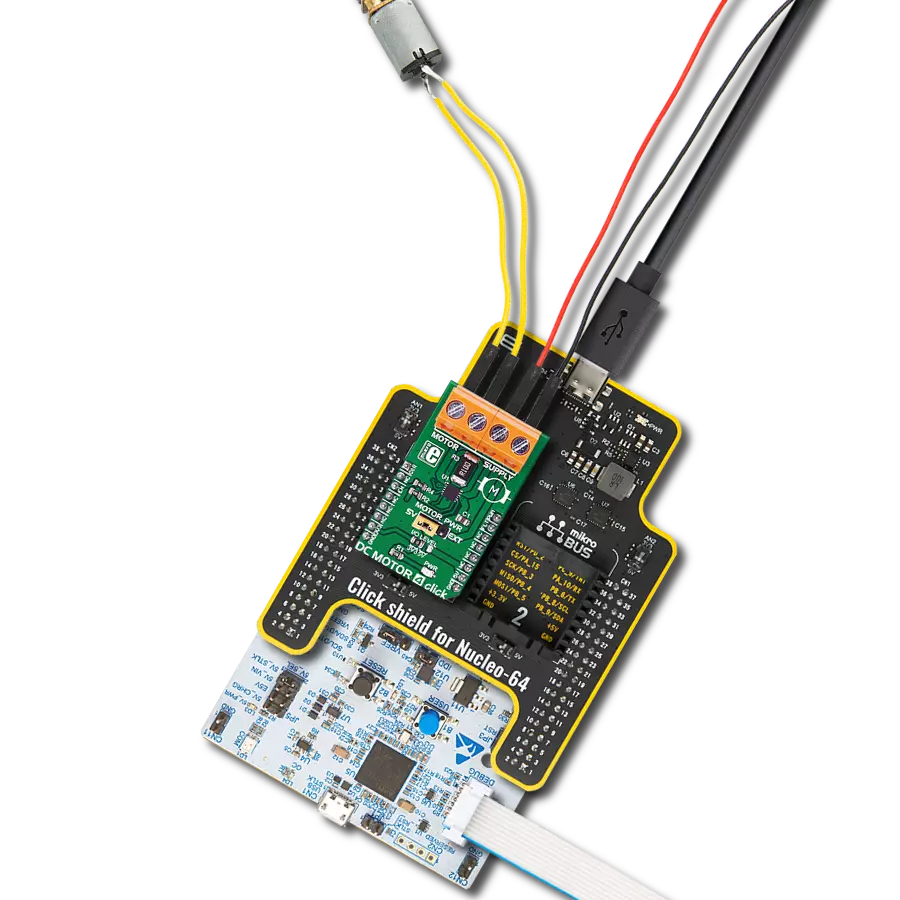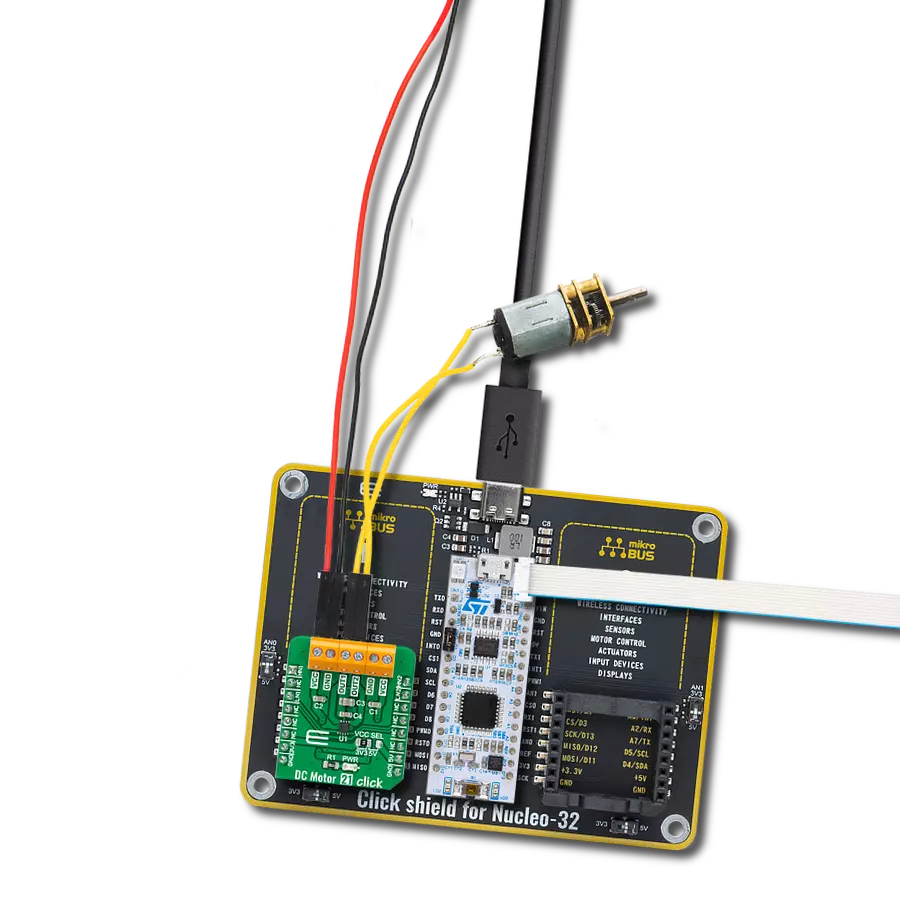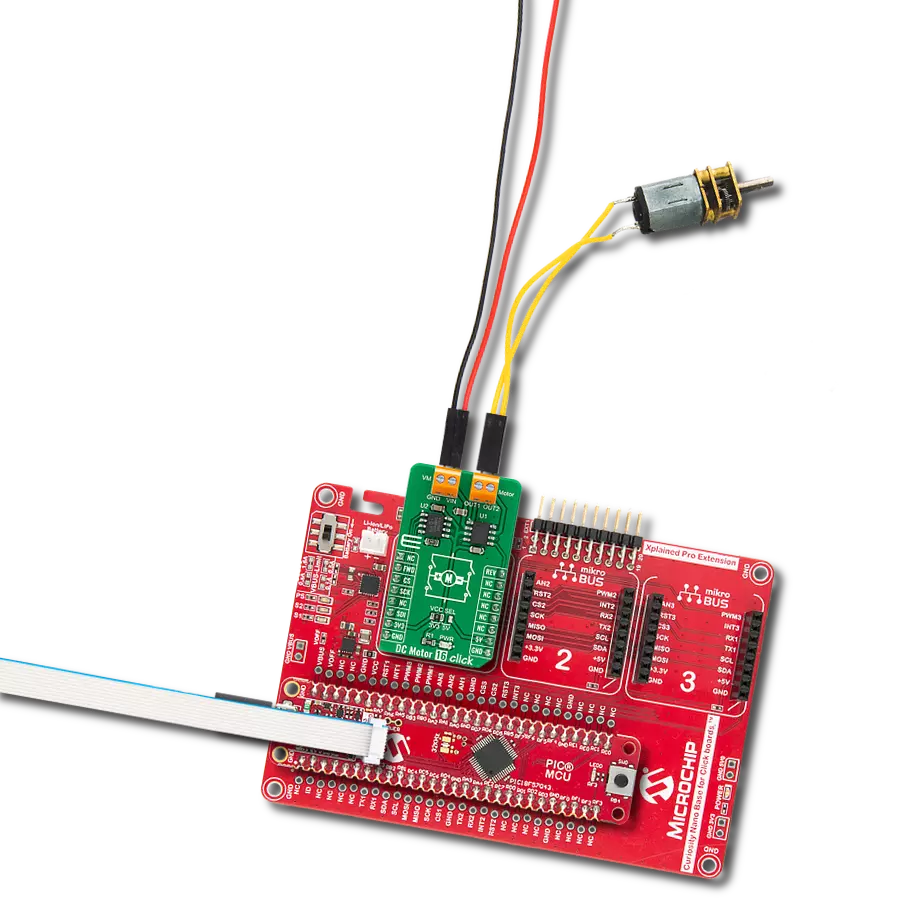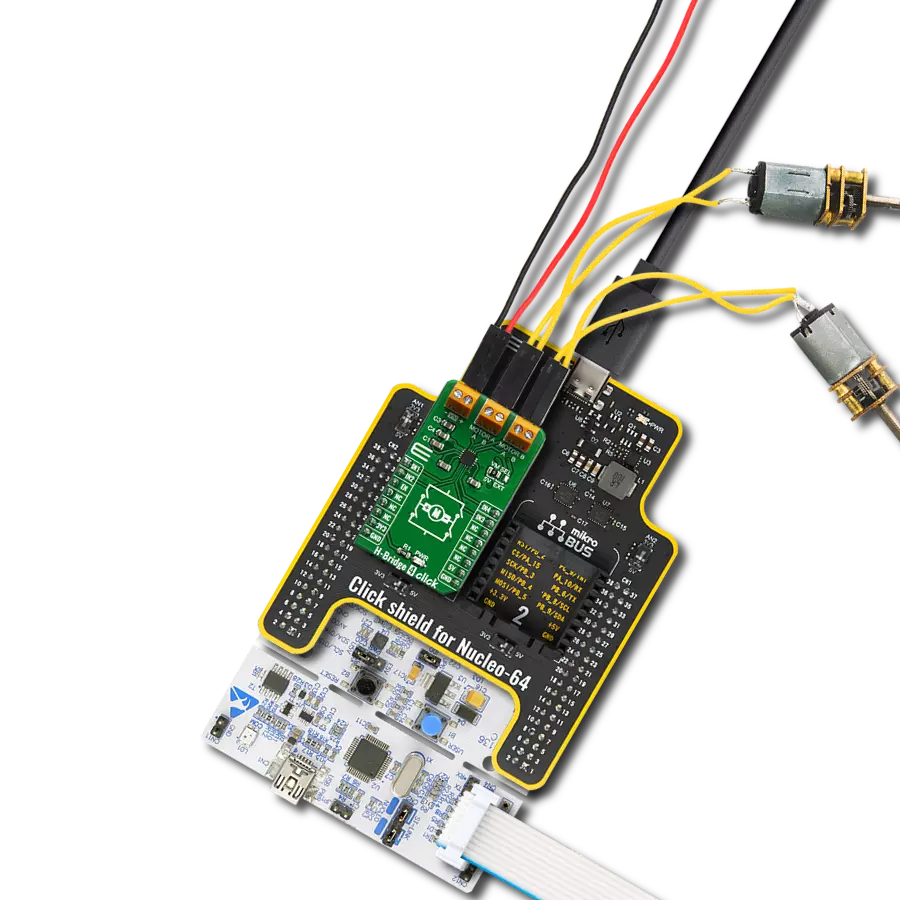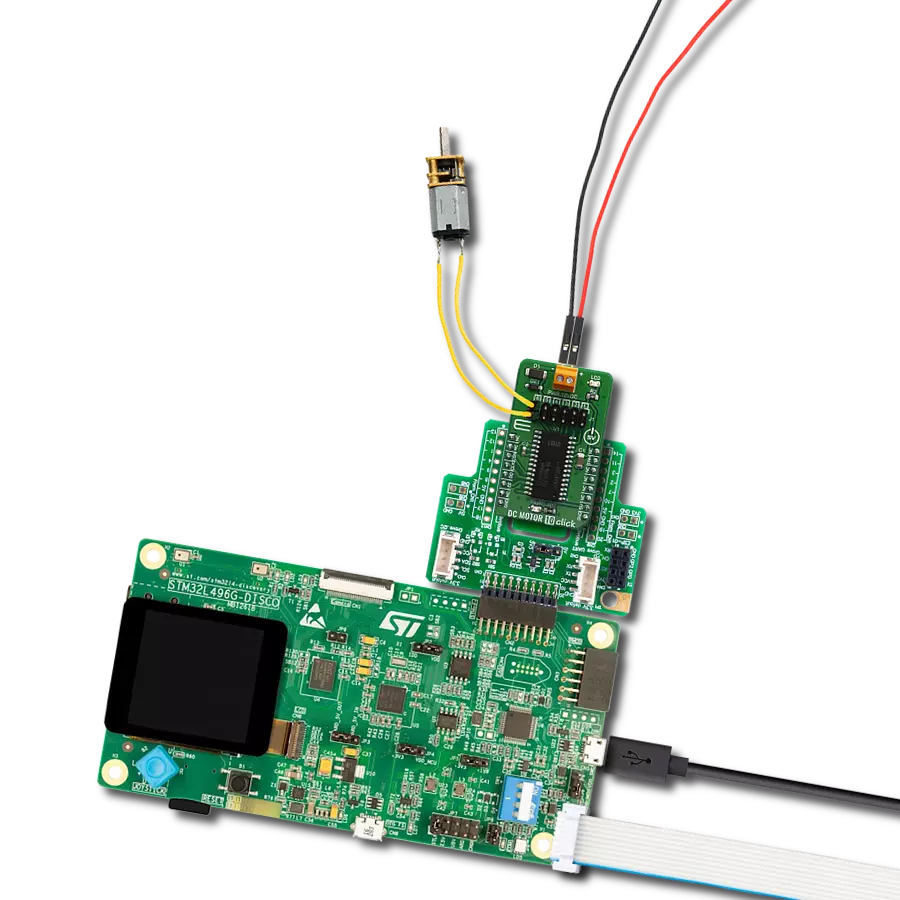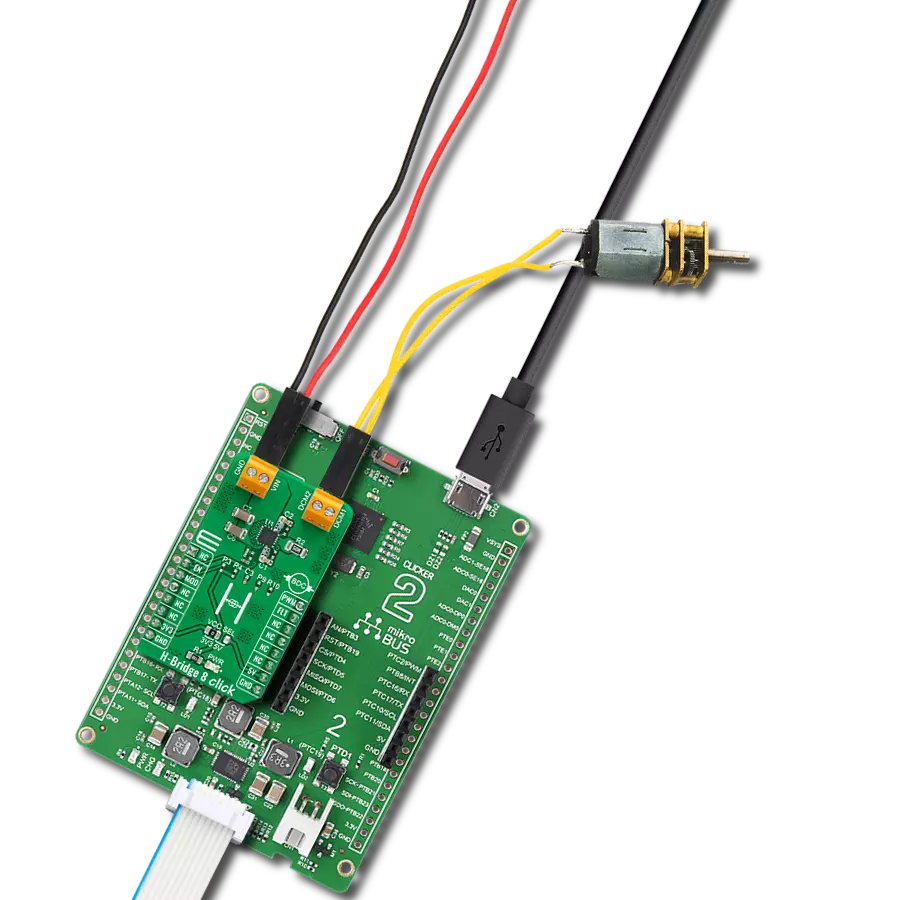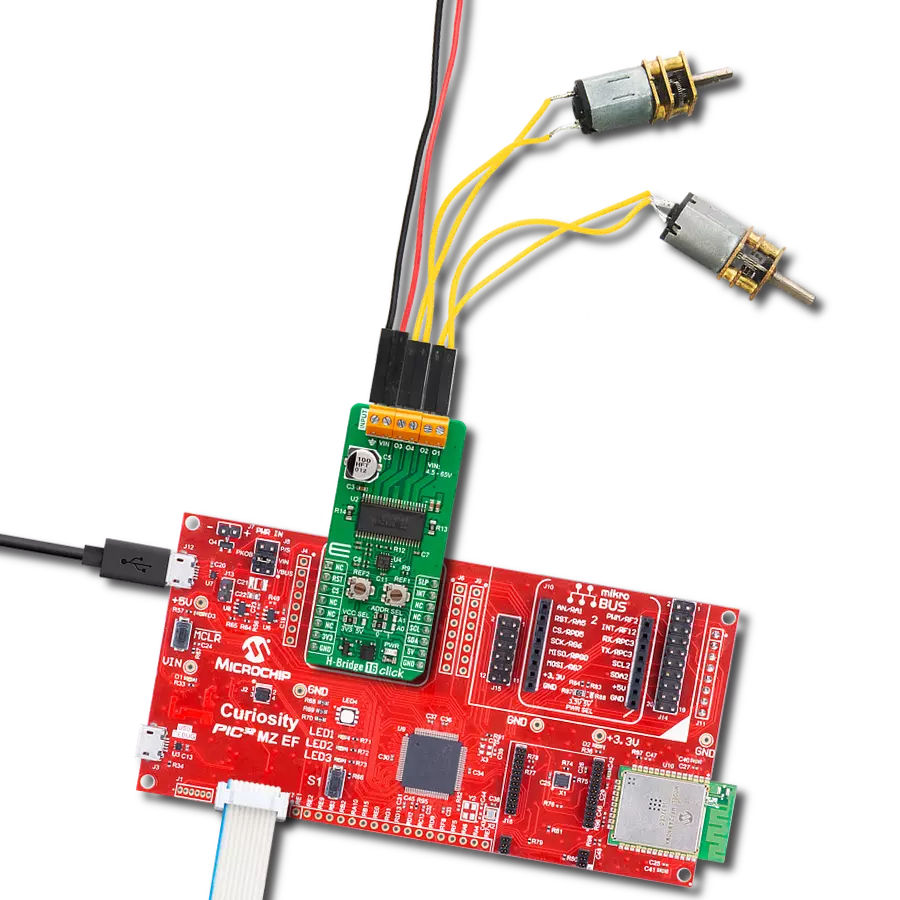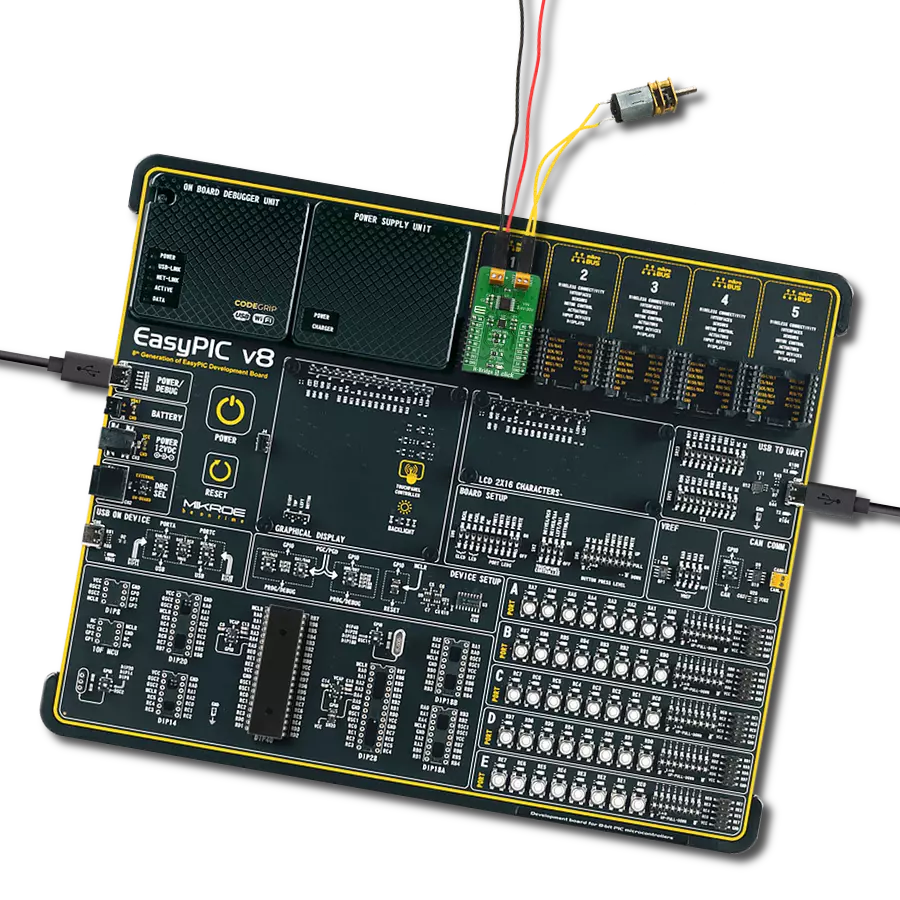Enhance your design, unlock the full potential of your DC motors, and attain versatile control across multiple operational modes
A
A
Hardware Overview
How does it work?
DC MOTOR 10 Click is based on the TLE 6208-6 G, a fully protected Hex-Half-Bridge-Driver explicitly designed for automotive and industrial motion control applications from Infineon Technologies. It integrates an efficient H-Bridge with a low ON resistance of approximately 0.8Ω through each branch. Furthermore, the built-in features like Over- and Undervoltage-Lockout, Over-Temperature-Protection, and the low quiescent current in standby mode open a wide range of automotive- and industrial applications. DC MOTOR 10 Click is ideally suited for the rapid development of various DC motor driving applications, including home appliances, printers, industrial equipment, mechatronic applications, and more. The part is based on Infineon Smart Power Technology SPT®, which
allows bipolar and CMOS control circuitry in accordance with DMOS power devices existing on the same monolithic circuitry. The six low and high-side drivers are freely configurable and can be controlled separately. Therefore all kinds of loads can be combined. In motion control, up to 5 actuators (DCMotors) can be connected to the six half-bridge outputs (cascade configuration). Operation modes forward (CW), reverse (CCW), brake, and high impedance are controlled from a standard SPI-Interface. Controlling the outputs via software from a central logic allows for limiting power dissipation. The internal logic of TLE 6208-6 G is supplied by the VCC voltage, typical with 5V. The VCC voltage uses an internally generated Power-On Reset (POR) to initialize
the module at Power-on. The advantage of this system is that information stored in the logic remains intact in the event of short-term failures in the supply voltage VS. The system can therefore continue to operate following VS undervoltage without having to be reprogrammed. The undervoltage information is stored and can be read out via the interface. This Click board™ can only be operated with a 5V logic voltage level. The board must perform appropriate logic voltage level conversion before using MCUs with different logic levels. However, the Click board™ comes equipped with a library containing functions and an example code that can be used as a reference for further development.
Features overview
Development board
Clicker 2 for Kinetis is a compact starter development board that brings the flexibility of add-on Click boards™ to your favorite microcontroller, making it a perfect starter kit for implementing your ideas. It comes with an onboard 32-bit ARM Cortex-M4F microcontroller, the MK64FN1M0VDC12 from NXP Semiconductors, two mikroBUS™ sockets for Click board™ connectivity, a USB connector, LED indicators, buttons, a JTAG programmer connector, and two 26-pin headers for interfacing with external electronics. Its compact design with clear and easily recognizable silkscreen markings allows you to build gadgets with unique functionalities and
features quickly. Each part of the Clicker 2 for Kinetis development kit contains the components necessary for the most efficient operation of the same board. In addition to the possibility of choosing the Clicker 2 for Kinetis programming method, using a USB HID mikroBootloader or an external mikroProg connector for Kinetis programmer, the Clicker 2 board also includes a clean and regulated power supply module for the development kit. It provides two ways of board-powering; through the USB Micro-B cable, where onboard voltage regulators provide the appropriate voltage levels to each component on the board, or
using a Li-Polymer battery via an onboard battery connector. All communication methods that mikroBUS™ itself supports are on this board, including the well-established mikroBUS™ socket, reset button, and several user-configurable buttons and LED indicators. Clicker 2 for Kinetis is an integral part of the Mikroe ecosystem, allowing you to create a new application in minutes. Natively supported by Mikroe software tools, it covers many aspects of prototyping thanks to a considerable number of different Click boards™ (over a thousand boards), the number of which is growing every day.
Microcontroller Overview
MCU Card / MCU
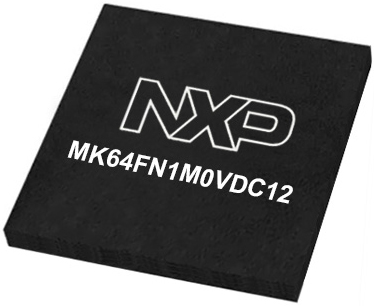
Architecture
ARM Cortex-M4
MCU Memory (KB)
1024
Silicon Vendor
NXP
Pin count
121
RAM (Bytes)
262144
You complete me!
Accessories
DC Gear Motor - 430RPM (3-6V) represents an all-in-one combination of a motor and gearbox, where the addition of gear leads to a reduction of motor speed while increasing the torque output. This gear motor has a spur gearbox, making it a highly reliable solution for applications with lower torque and speed requirements. The most critical parameters for gear motors are speed, torque, and efficiency, which are, in this case, 520RPM with no load and 430RPM at maximum efficiency, alongside a current of 60mA and a torque of 50g.cm. Rated for a 3-6V operational voltage range and clockwise/counterclockwise rotation direction, this motor represents an excellent solution for many functions initially performed by brushed DC motors in robotics, medical equipment, electric door locks, and much more.
Used MCU Pins
mikroBUS™ mapper
Take a closer look
Click board™ Schematic

Step by step
Project assembly
Software Support
Library Description
This library contains API for DC Motor 10 Click driver.
Key functions:
void dcmotor10_resetStatusReg();- Function is used to reset status register.void dcmotor10_enableChann1();- Function is used to enable channel 1.void dcmotor10_sendCommand( uint16_t wrData );- Function is used to send command.
Open Source
Code example
The complete application code and a ready-to-use project are available through the NECTO Studio Package Manager for direct installation in the NECTO Studio. The application code can also be found on the MIKROE GitHub account.
/*!
* \file
* \brief DcMotor10 Click example
*
* # Description
* This example is running dc motors on channels 1 through 3.
*
* The demo application is composed of two sections :
*
* ## Application Init
* Initalizes SPI, Click drivers and uninhibites the device.
*
* ## Application Task
* This example demonstrates the use of DC MOTOR 10 Click by running dc motors
* on channels 1 through 3, first all 3 together and then separately.
*
* \author Jovan Stajkovic
*
*/
// ------------------------------------------------------------------- INCLUDES
#include "board.h"
#include "log.h"
#include "dcmotor10.h"
// ------------------------------------------------------------------ VARIABLES
static dcmotor10_t dcmotor10;
static log_t logger;
// ------------------------------------------------------ APPLICATION FUNCTIONS
void application_init ( void )
{
log_cfg_t log_cfg;
dcmotor10_cfg_t cfg;
/**
* Logger initialization.
* Default baud rate: 115200
* Default log level: LOG_LEVEL_DEBUG
* @note If USB_UART_RX and USB_UART_TX
* are defined as HAL_PIN_NC, you will
* need to define them manually for log to work.
* See @b LOG_MAP_USB_UART macro definition for detailed explanation.
*/
LOG_MAP_USB_UART( log_cfg );
log_init( &logger, &log_cfg );
log_info( &logger, "---- Application Init ----" );
// Click initialization.
dcmotor10_cfg_setup( &cfg );
DCMOTOR10_MAP_MIKROBUS( cfg, MIKROBUS_1 );
dcmotor10_init( &dcmotor10, &cfg );
Delay_ms ( 100 );
dcmotor10_inhibit(&dcmotor10, DCMOTOR10_UNINHIBIT );
dcmotor10_send_cmd( &dcmotor10, DCMOTOR10_RESET_STATUS_REG );
Delay_ms ( 100 );
}
void application_task ( void )
{
dcmotor10_send_cmd( &dcmotor10, DCMOTOR10_ENABLE_1 | DCMOTOR10_ENABLE_2
| DCMOTOR10_ENABLE_3 );
Delay_ms ( 1000 );
Delay_ms ( 1000 );
Delay_ms ( 1000 );
Delay_ms ( 1000 );
Delay_ms ( 1000 );
dcmotor10_send_cmd( &dcmotor10, DCMOTOR10_ENABLE_1 );
Delay_ms ( 1000 );
Delay_ms ( 1000 );
Delay_ms ( 1000 );
Delay_ms ( 1000 );
Delay_ms ( 1000 );
dcmotor10_send_cmd( &dcmotor10, DCMOTOR10_ENABLE_2 );
Delay_ms ( 1000 );
Delay_ms ( 1000 );
Delay_ms ( 1000 );
Delay_ms ( 1000 );
Delay_ms ( 1000 );
dcmotor10_send_cmd( &dcmotor10, DCMOTOR10_ENABLE_3 );
Delay_ms ( 1000 );
Delay_ms ( 1000 );
Delay_ms ( 1000 );
Delay_ms ( 1000 );
Delay_ms ( 1000 );
dcmotor10_send_cmd( &dcmotor10, DCMOTOR10_RESET_STATUS_REG );
Delay_ms ( 1000 );
}
int main ( void )
{
/* Do not remove this line or clock might not be set correctly. */
#ifdef PREINIT_SUPPORTED
preinit();
#endif
application_init( );
for ( ; ; )
{
application_task( );
}
return 0;
}
// ------------------------------------------------------------------------ END
Additional Support
Resources
Category:Brushed



















